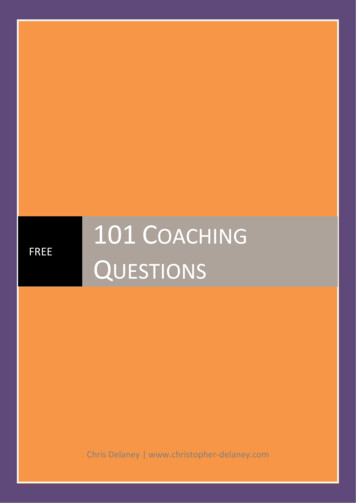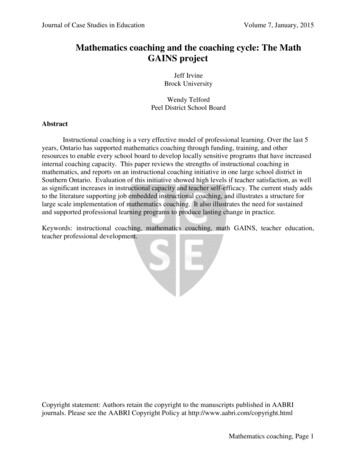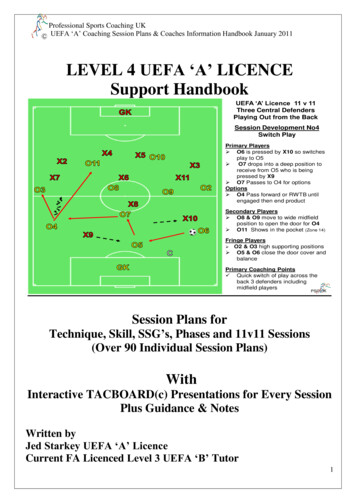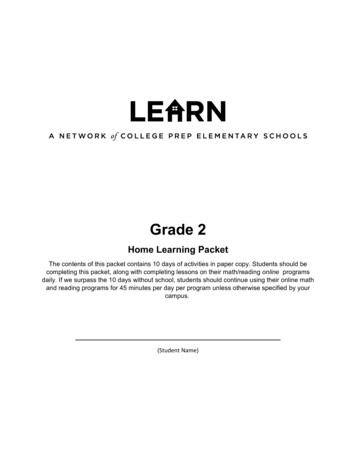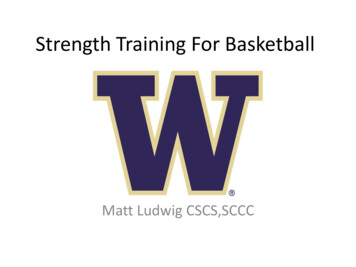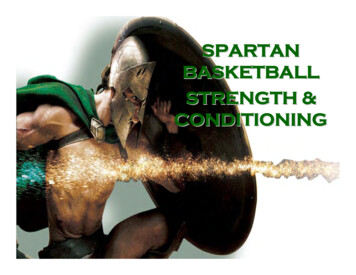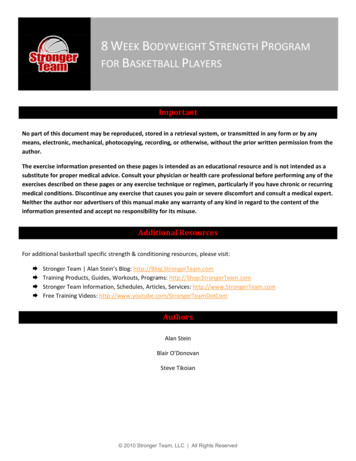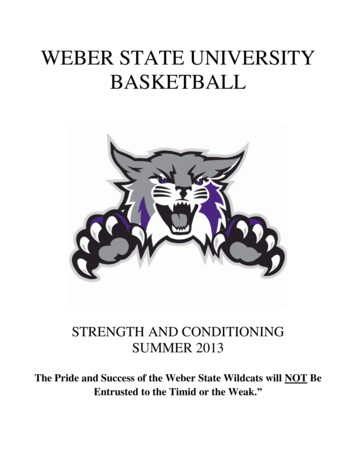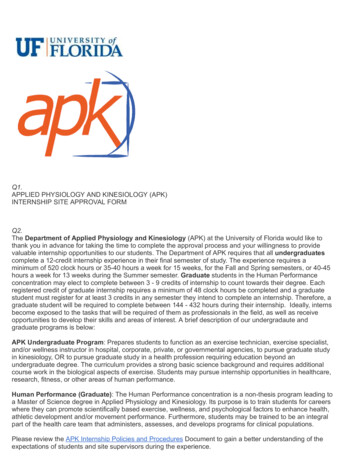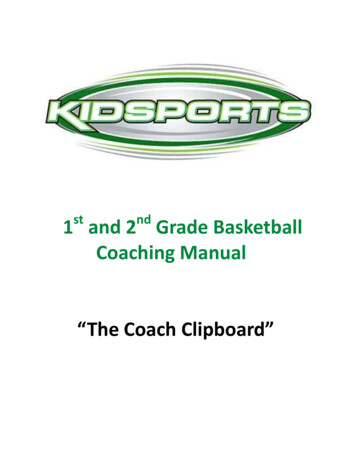
Transcription
stnd1 and 2 Grade BasketballCoaching ManualThe Coa h Clip oard
Thanks for Coaching!First let us thank you for volunteering to coach for Kidsports. We know that it is asignificant commitment of your time and energy. By coaching you are helping to provide awonderful athletic experience for youth in our community. Kidsports would not be able to dowhat is does without the help they receive from members of the community like yourself.Sports participation is important because it teaches children the value of physical fitness,sportsmanship, practice and team work. Our hope is that each player is allowed to achieve theirpersonal best while having fun. This manual will hopefully give you some ideas and resourcesthat will prepare you to be able to create a sport environment for all your players that allow themto achieve their personal best.while having fun.1st and 2nd grade BasketballBasketball can be a challenging sport to teach the young player. This guide is designed to giveyou some tools and information that will help you organize your season and practices in a wayso that your players will be successful. The first and second grade player can range between 6 8 years old. Coaches of players in this age range need to focus on teaching the fundamentalmovement skills in addition to basic fundamental basketball skillsPhysical skills:Developing fundamental movement skills; pushing , pulling, lunging, squatting, bending,twisting ,throwing, catching, jumping, jogging, running; needs to be the primary focus at thisage. All of those movements need to be combined to develop; agility, balance, coordinationand speed. Making sure that each child gains proficiency in these basic athletic skills will enablethem to develop to their full physical potential in later years.Basketball skills:Focus needs to be on developing fundamental basketball skills; stance, footwork, dribbling,passing and shooting. In addition as a coach you also want to help the young player develop alove and passion for the game. Motivation to master the game of basketball is a fundamentalskill that all coaches need to focus on developing in their players. Enjoyment is the mosti po ta t i g edie t i de elopi g oti atio i ou g pa e s. To put it si pl ; if the do ’te jo it, the o ’t pla it.Technical skills:In addition to fundamental basketball skills the young player needs to be introduced to thebeginnings of technical basketball skills. These skills involve decision making or problem solving.For this age the problems that they must learn to solve are simple: Shoot or pass? Dribble to theright or the left?
The FUNdamental StageDevelopmental y oriented (egocentric)*Short attention span*Easily bruised psychologically*Perform tasks one at a time*Influence of peers is very strong*Limited tactical abilities*Biggest concern is which way to go when they have ball.Physical/Motor:*No sense of pace.will often run until they drop*Running, jumping, skipping, hopping and maintaining balance are not fully developed at thisage.*Large muscle groups are more developed than smaller ones.*Needs to develop speed/fast twitch abilities.*Will often fall when changing direction because of high center of gravity.*Need multiple breaks during practice and games.Psycho– social:*Typically this if first exposure to team sport.*Need to feel secure in practice and games *Social development is limitedCoaching Consideration:*Gi e sho t & lea di e tio s ith a folloe app oa h.*Coach needs to guarantee success for all players through proper structure of practices*Coach needs to provide appropriate positive reinforcement often.*Work on speed when players are fresh*Use several short activities*Lots of water breaks*Short training session (45min– 1hour)*Emphasize confidence and familiarity with the ball (every child needsTo have access to a ball for entire session)*Give plenty of encouragement and very little criticism or correction.*Primary focus is making basketball so enjoyable that when the child haschoices in activities, they choose to play basketball.
Fundamental Skills for 1st and 2nd gradeFundamental movement skill:Agility, balance, coordination(throwing and catching), proper running technique, changeof speed and direction, jumping and landing, starting and stopping (stride stop and 2 foot dropstop), pivotingBasketball skills:Ready position, triple threat, play with eyes up.Ball handling:Ball control, stationary dribbling (low, high, and wide), movement while dribbling(running, sliding, walking, change of direction, starts, stops, low, high)Passing skills:Stationary passing, moving and passing, passing to a teammate, receiving the ball(absorbing) catching on the move, catching the ball with 2 hands.2 eyes.and 2 feetShooting skills:Squaring the feet and shoulders to the target, pushing with both legs, proper hand andarm placement (hand under/behind ball, fingers spread, elbow under ball/over knee), followthrough (release). Learn first without the ball then with the ball. Close range shots, lay-upprogression.Playing Principles:Basic offensive concepts, advancing the ball toward your offensive end, shooting the ballinto the basket to score, spacing of players (4 - ’ apa t , utti g of pla e s (away from balltowards basket)Basic Defensive concepts:Recognition of when you are on defense, recognition of the person you are defending,when defending the ball staying between the person you are guarding and the basket, whenyou are defending away from the ball staying between the person you are guarding and thebasketCoaching in the FUNdametnal StageIt cannot be emphasized enough that the goal for this level is Not to i , ut rather toha e fu hile playi g sports a d e suri g su ess . The players need to learn fundamentalmovement skills through basketball in a fun and positive way. This not just because we wantthe kids to have fun, which of course we do, but also because learning those fundamentalmovements will allow each child to reach their fullest potential. If they are having fun they willbe more likely to continue participating. It is the oa h’s u er o e respo si ility toguarantee success for every child. This does not mean that each child will be a great dribbler orshoot the ball well. What this does mean is that as a coach you have give challenging, yetachievable goals for your players. If a player starts the season not being able to dribble the ballor make a 2 footed jump-stop and then during the season is able to dribble more effectively andmakes a jump-stop in a game, that is success! If the only way a player can be successful on yourteam is to make a layup or be the best player on the team, then a good percentage of yourplayers will never feel successful.
Sample Practice structure:60 minuteso Warm-up: including speed work and agility: 5-10 mineso Technical skills and drills: 35-40 minso Scrimmage and simple tactics: 10-15 minso Cool downHow to make your practices fun:Make your practices fast paced:o Plan ahead. Planning is the number one key to a successful, fun practice.o Move from drills and games quicklyo Limit time standing in lineso Planning and organization are key to being able to run your practice effectively.Set rules and expectations:o Your practice will be more fun if everyone knows what is expected from them interms of behavior and efforto Rules help keep the practice organized and running smoothly. They also helpkeep the kids safe Communicate rules both verbally and in writing. Make sure parents areaware of the rules. Be o siste t ith ou ules. If ou do ’t appl the fai l a do siste tl , ou pla e s o ’t u i to the .Get your players attention:o Establish a quick signal or technique to get your players attention quickly. ie: Long whistle, verbal cue from coach, clap cue.o Keep talking and instructions short! You will lose them if you talk or instruct toomuch. Remember they will learn by doing!Make sure your players are successful:o Run a mix of drills of varying difficulty so that every player has the chance tosucceed.o Verbally praise and reward success. Praise progress! Remind players of howmuch they have learned so far.o Praise effort! Players who work hard and give maximum effort need to berewarded.Be positive and upbeat:o Your attitude is key. Your players will feed off your attitude, if you are down theywill be down but if you are energized and positive they will be too.o Keep goals clear for yourself. Remind yourself often that winning all your gamesis not the goal. Measure your success by the progress of your players and theirenjoyment of the game and you will stay positive.Plan and structure your practices properly:o Again planning out your practices is the most important part. Have a writtenplan so that you know exactly what comes next in your practice. Plan in breakso If you have a new skill or drill to teach the team, do that at the beginning ofpractice when the players will be most attentive.o Each drill should be between 3 -5 minutes.
o Plan fun games in between more challenging, difficult drills.o Plan drills that take a lot of time to set up after breaks so you can have time toset up without making the team wait.o Have your players help set up drills. This will keep them engaged and also makethe set up quicker.o Be creative! You can make up games and competitions out of almost anything.Also if a drill only requires 4-5 players, you can give the other players ballhandling or movement drills to keep them busy while they wait. That way notime is wasted.o Always end your practice on a positive note.How do make your drills fun:o Be creativeo Turn any drill into a game: Track missed shots, give points for achieving something: ie passes layup,jump-stops, etc.o Use tag, Red-rover, sharks and minnows and other childhood games toincorporate basketball skills in a fun way in your practices.o Add props like cones (to dribble through), chairs (to teach proper defensivestance), or other items to add fun into the practice. Again your imagination iske . e eati eThe GameThe askets a e set at ’ a d the f ee th o li e is at ’. The use a ju io all. O lman to man defense is allowed and no back court guarding is allowed. Double teaming is notallowed until the ball is advanced below the free throw line. The game consists of 8 periodsthat are 5 minutes in length. The clock is a running clock, which stops during timeouts and foulshooting lineups. No score is kept. Teams must provide their own volunteer refs. Each coach orassistant coach can do the officiating. The main objective is to keep the game safe, facilitate thegame being productive for both teams and instruct all players when mistakes or violations aremade.
Sample Practice PlanDate:Team:Practice length:Focus:Practice sectionDrill/gameDynamic warm-up: *Follow the Leader: 4 mins10 minsCoach starts and then players taketurns leading the group*Race to the Spot: 3 minsOn coaches command players raceto different spots*Coach Says: 3minsPlayers listen and perform whatWATER BREAK*oa h sa sTechnical skills:*Pound the ball: 3 mins30minsAll players with a ball on end lineDribbling*Left and Right:5 minsAll players with a balldribble right hand down the courtand left and back*Dibble Tag : 5-6 minsmark off about ¼ of the court withconesha e pla e s sta t at itCoaching points/comments*jog, skip, lunge, hop, sideslides, high kicks, etc.*free throw line, 3 pt line,block, etc. Emphasizequickness and quick first step*bear crawl, 2 foot jumps,backward skip, lateral slide etc.*I st u t the to pou d theall ha d a d lo the ha dand high.* Start out slow and progress tojogging.*remind players to keep eyesup*If they are tagged theye o e it* do short 1 min rounds andthen switch.WATER BREAK*Passing*Give and Go: 4-5min2 lines about 10ft apartStart with chest passes*player passes and then runs tothe end of the other line.*Monkey in the middle: 5 minsGroups of 3, one ball per group*player in the middle tries to getthe pass*demonstrate a proper pass*remind them to pass with 2hands and snap at the finish*receiver needs to ha e softhands and catch with 2 hands,2eyes, and 2 feet.*remind them to fake a passand then make the pass.*do short rounds of 30 secondsand then switch roles
Passing*Ultimate basketball:5 minsDivide players up into 2 teams.Use the whole court.WATER BREAK*Team*Defend the house:4-5 mintactics/scrimmage:Divide players into 2 teams of 515 minsObject is to get them to transitionfrom offense to defense quickly.*players can only pass notdribble.* emphasize good passes andgetting open for a pass.*start with one team spreadout offensively under one hoopwith other team on defense*on whistle offensive team runsto defe d the housegetting on down the court andset up in between their playerand the hoop. Do a couple ofrounds without the ball andthen add the ball.3 v 3 v 3 or 4 v 4 v 4: 10 minsDivide players up into groups of 3or 4Cool Down: 5 min*Circle stretch: 5mins*Team cheer!*let them play 3v3 and have theother group of 3 stands at thehalf.*on a change of possession theteam in the middle becomesdefenders at the other end.*Coach in center of circle*lead through series ofst et hes fo us o i easi gflexibility and balance*Have teammates take turnsleading this later on.
Sample Practice PlanDate:Team:Practice length:Focus:Practice sectionDrill/gameDynamic warmup: 10 mins*I can can you?: 5 minsCoach calls out something they cando such as skip, run backwards,hop, skip backwards etc. andplayers try it too.*My Shadow: 5minsPair up players. One is a shadowa d o e is it . “hadoust staclose to partner.WATER BREAK*Technical skills:30mins*Ready? : 3 minsAll players in lines in front of coachspread out.Briefly show ready position, havethem show you.*Jump to triple threat: 5minsTeam lined up on end line.On command players run to otherend. On whistle players do a jumpstop to triple threat position.Add a pivot (demonstrate first)Coaching points/commentsGive players turns callingout different things thatthey can do.Players must stay closeface to face and within 5feet of each other.Maintain athletic stanceand eyes up.Ha e the do fastfeet a d on yourhistle ou ell a e ouead ? . Tea gets iready position and yellsa k READY!Briefly show them triplethreatRemind them to staylow and balanced.Start with no ball andprogress to having ballAdd ball with dribbling to drill.*4 corner pivot drill:5minsPlayers divided up in equalnumbers on each corner of the ½court.Do several rounds, alternate feetand how they high fiveAdd ball to dribble to middle andpivotRun to middle, jumpstop and pivot on theirright foot.Players run back to samecorner and slap handswith next in lineRepeat.
WATER BREAKTactical: 10 minsCool Down: 5 min*Bird on a Wire: 5minsOne person is it. All other playershave a ball and are on the end line.Pla e that is it has to sta o thehalf court line.Bird tries to either tag orsteal the ball of theplayers trying to dribbleA player that is taggedbecomes a bird too.*Form shooting: 5-8 mins“ta t ith o all, just i agi aball.Do several rounds with no ballAdd ball and have them shoot onwallProgress to hoopRemind about readyposition.*2 on 1 Shooting drill: 5 minsli es offe se at top) and onedefense( under basket)2 players on defense and on playeron offenseRotate lines.*Pistol defense: 5mins Set up 5 on 5 (use colored pennies) E plai a d de o st ate pistolso all a d a Start with no shooting andprogress to having a scrimmage.*Walking stretch/cool-down: 5 mins 2 lines that follow coach Slowly walk around court doingvarious stretches. High knee grab,quad stretch, toe touch, sidelunges, etc.*Team cheer!pizza ha d, el ounder ball/over kneesFollow through toookie jaEmphasize looking foropen playerTaking a good shot*remind them to move as ballmoves.keeping a triangle ofou, a , all*pass ball around and havedefense practice.Do 1-2 minrounds and switch. Take this time to offerpraise to players forprogress and effortduring practice.
Drills and GamesWarm-up & Movement drills/games:Follow the Leader:Basic game of follow the leader. You start off as the leader and get them moving. Jogging,sliding, jumping, lunging, skipping, the options are limitless. After they get the idea of the drilllet the players take turns being the leaderRun to the Spot:Designate several areas around the court such as 3 point line, free throw line, low block, elbow,you can mark these with cones to make it easier. The players start close to you and on yourcommand they run to the spot you call out as quickly as possible and back. Emphasis is onstarting in an athletic stance, a quick first step, and speed.Coach Says:Ga e is like “i o “a s ut i stead ou ha e the pe fo tasks he Coa h sa s . Thi gslike jump on one foot, do 5 defensive slides to the left, show me Triple Threat position, etc. Useyour imagination. When a player reacts when a command is given without coach says in thecommand, that player is out until the game is over.Throw and Catch:On coaches command all the player throw their ball up into the air and catch it. Start onlythrowing is a foot or 2 in the air and increase as they master it.Throw-Clap-Catch:Variation of previous drill. Add clapping in between throwing the ball in the air and catching it.Increase the height they throw the ball and increase the number of claps. This can progress toThrow-spin-clap-catch to make it more difficult.Circle the Basketball:Have all the players stand with their ball facing you. On your command have them start to circletheir ball around their waist. Have them go around several times and then change directions.Have them circle around their heads for several times and then around their knees. At the endhave them start at their head and circle the ball all the way down to their knees and then backup.Box Run Relay:Divide team up into 2 teams. Mark off 2 sections of the half court from one side of the key tothe sidelines and up to the half court line. Have each team line up on the base line on oppositesides of the key. On the coaches command the first player from each team will shuffle down thebaseline. As they reach the corner of the court the players back pedal to the half court mark. Athalf court they will shuffle to the ball jump area. At the ball jump area the players will sprint tothe starting line, tag the next player who then continues the relay.
Catch the Tiger's Tail:Use shi ts o pe ies, ha e the half the tea put the i to the a k of thei sho ts so that it ishanging out like a tail. Section off a small area of the court that is the playing area. Have thepla e s ho a e it t to g a the Tige s tails. If the g a the tail the ill e o e the Tige ithe e t ou d. You a a hoaTige s ou ha e a d hoahase s depe di g othe skill and speed of your players.Tag:Simple game that can be modified and used in many different ways. Everybody is it, Freeze tag,flag tag (use flag football belts with flags), etc. Use without a ball and with a ball. Be creative!Run and Jump:All players spread out across base line. Have them run towards other baseline, on your whistlethe players jump or leap from one foot and land on both feet. Focus should be on landing lowand balanced. Give points to players who don't fall forward and who land balanced and low. Doseveral rounds.Frogs in a Pond:Place cones a couple of feet apart all the way across the court from sideline to sideline. Instructplayers that they are now frogs who must jump across the pond (court) Start with havingplayers jump with two feet from cone to cone. Then have them try jumping from one foot andland on the other foot from cone to cone.Square Sprint:Pair up players. Make a small square with cones for no more than 10 ft across. Have one cone inthe center. Have the pair number the cones. On player starts by the center cone. The otherplayer calls out a number and the player in the center must run and touch that cone as quicklyas possible. Progress to calling out 2 numbers at a time and then 3.etc. Focus is on stayinglow, not crossing the feet, quickness, agility. Do rounds of 1 minute and then switch.Mirror Shuffle:Pair up players. Have players face each other along the baseline. No ball is needed. Have oneplayer start as the defensive player. They get into the defensive stance. The offensive playersimply jogs in a zig zap manner down to the opposite baseline. The defensive playershuffles/slides to keep in front of the offensive player. When they get to the baseline playersswitch roles and proceed back to the start line. You can progress and add the ball into the drill.The offensive player dribbles zig zag down the court.
Technical Drills and Games:DribblingStationary Dribble:All players on the baseline with a ball. Have players start in ready position (feet apart, toespointed forward, knees bent) and with ball in Triple Threat position. Have them dribble with theright hand. Vary between low/high/hard/ soft/ wide. Have them dribble with left hand. Addmore options as they develop. Front Crossover in front, pull back and forward,Red-light/Green light:Have all players line up on the baseline with a ball. On your whistle the players begin dribblingtowards the other baseline. Have them walk for the first couple of rounds. On the next whistlethe pla e s ust stop eithe ith a st ide stop o ju p stop a d get i to the ead -tripleth eat positio . If the lose o t ol of thei all o do 't iediatel stop the ust etu tothe baseline. The first player to make it to the opposite baseline is the winner. On the returntrip have them use the left hand. Progress to having them run and dribble.Queen/King of the Court:All players with a ball in designated area (¼ court, ½ court or full court depending on skill of theplayers) the smaller the court the more difficult the drill. On your whistle all players begindribbling and moving around trying to knock or tap other players balls out of bounds. If apla e ’s ball is knocked out of bounds or if the player steps out of bounds, they are out. The lastplayer still dribbling in bounds is the Queen or King of the court. Do several rounds. You canprogressively make the playing area smaller as the number of players is reduced.Snake Dribbling:All players with a ball. Players form a winding line in the middle of the court; they are spaced afew feet apart. The players all begin dribbling while in the line. The player at the end of theline must dribble through the line weaving in and out of the other players until they reach thefront of the line and stop (they continue dribbling in a stationary position) each time a player isat the end of the snake they must work their way to the front and stop. You can progress withthis drill to having the snake move around the court, have the players in line try to knock theball away from player attempting to make their way to the front of the line and have players usetheir non- dominate hand.Staring Dribble Drill:Pair up players according to skill and size. Have players face each other and hold the ball inwhatever hand they wish. On your whistle the players must begin dribbling and staring intoeach othe ’s eyes. If a player blinks, looks away or looks down at their ball the other playerearns a point. They begin a new game. The first player to 5 points wins. You can use manyvariations of this drill; use their weak hand only, allow them to move around, switch uppartners; add a second ball for more advanced players.SPLAT:All players have a ball and stand with the coach in the center circle in the middle of the gym.The coach has a soft ball (nerf or other soft skin ball). The coach calls out a pla e ’s name and
throws the soft ball into the air. The player whose name was called puts down their basketballand runs to get the soft ball. All other players dribble as fast as they can away from the playerith the soft all. Whe the pla e at hes the all a d ells stop all players must stopimmediately and put their ball down beside them. The player with the soft ball can take 3 stepstowards the closest player and try to throw the ball at them. If the target is hit they have to givetheir ball to the player who got them out and return to the center circle. If the target catchesthe soft ball or the player throwing the ball misses, the original person stays in the middle.Everyone returns to the middle and the ball is thrown into the air again.the coach calls a newname each time.Bird on a Wire:All pla e s a e o the ase li e ith a all. O e pla e is the i d a d is sta di g o a li e thatgoes across from sideline to sideline. On the coaches command all the players speed dribblea oss the ou t to the opposite aseli e. The i d t ies to tag the pla e s t i g to oss thecourt but must stay on the line. They can run all along the line. If a player is tagged they get ridof their ball and become a bird too. Do several rounds. You can vary this by staggering thei ds o diffe e t li es a oss the ou t a d ha i g the steal the all i stead of taggingthe player.Sharks and Minnows:All players stand on one end of the gym with a ball. All of these players are Minnows. Pick acouple of players to be Sharks. The Sharks have a ball too. On your command the Minnows tryto dribble their ball across the SEA without being tagged by the Sharks, who also must dribbletheir ball while trying to tag the Minnows. If the Minnow is tagged they become an Octopusand must freeze and put their ball between their feet. The Octopus can tag players but cannotmove. Repeat until you have a winner or everyone is eaten. You can make this game moredifficult by having the players use their non dominate hand or increasing the number of Sharks.You can make it easier by allowing them to use both hands to dribble or decreasing the numberof Sharks or increasing the size of the SEA.Musical Cones or Hula Hoops:This is a fun dribbling drill that is a twist on musical chairs. Hula Hoops make the game reallyfun but you can substitute cones if you don't have access to 10 Hula Hoops. Each player gets ahula hoop or a cone and a ball. The players spread out around the court. On your whistle (or ifyou have music in your gym.when the music starts) the players start dribbling around thecourt. The coach removes one to the hula hoops or cones. On the oa h’s next whistle (orwhen the music stops) the players must speed dribble and get one foot inside the hula hoop, orone foot on the cone. The player without a hula hoop or cone is out of the game. Continue untilonly one player remains. Vary the game requiring certain types of dribbling or allowing playersto knock the other pla e ’s balls away during the game.Dribble relays:Form 2 or 3 teams. The teams are lined up on the baseline. The first 2 players in each line havea ball. On your whistle have players dribble up and down the court as quickly as they can whilestaying in control. Have players dribble down the court with their right hand and back withtheir left. Once the player reaches the starting point the next player goes. Remind players tokeep their eyes up. You can add things to this drill such as jump-stops w/ pivots at the other
baseline and/or have them do a change of direction dribble at the half court, such as acrossover, spin move or step back dribble.Dribble Around Cones:Divide team into 2 or 3 groups. Have groups line up in a straight line on one base line. Set upcones down the court about every 5 ft. You can have the cones in a straight line or in a zig zagpattern. On you whistle have the first player in the line dribble through the cones and back.Vary this drill by having the players use their non-dominate hand.Dribble Around Defenders:Have 4 or 5 players stand down the center of the court. These players can't move their feet, butthey can use their hands and lean for the ball. The other players start from one end and try todribble in a weave pattern through the defenders. The goal is to get through the defenderswithout losing control of their ball or having it touched by a defender.1 V 1 dribbling:Pair up players according to skill and size. Line up pair either along the base line or across thesideline (depending on how many pair you have. You want each pair to have lots of space)One player has the ball and is on offense. The other player lines up about 3 ft away and is ondefense. The object for the offense is to try to dribble the ball across the court, the defensetries to steal the ball or stop the dribble of the offense.PassingLine Coach Pass:Line up all players in a line facing the coach. Each player has a ball. Have each player pass theball to the coach and the coach passes it back to the player. This is a good drill to introducepassing to players. It allows the coach to instruct all players on the proper passing technique.Have players focus on passing and catching with 2 hands, 2 eyes and 2 feet. Watch for playersstepping into the pass and snapping the hands towards the target. Make sure the whenreceiving the pass the players hands are ready and in the proper position. Do several rounds upand down the line. Show both the chest pass and the bounce pass.Wall Pass:Each player has a ball. Have players find a spot on the wall. Have player start making a bouncepass to the ball and catching the return. Progress to players performing a chest pass andcatching the return.Partner Pass:Pair up players based on skill and size. Have each pair have a ball. Have pairs stand about 5- 10ft apart. Have players pass back and forth start with bounce passes and then progress to chestpasses. Remind them of good passing and receiving techniques.
Give and Go:Divide team up into 2 lines facing each other about 10ft apart. One ball is needed. The firstperson with the ball makes a chest pass to the opposite line and then runs to the end theopposite line.Passing Line Relay:Divide team into 2 equal teams. Line them up across the court form sideline to sideline about5ft apart. The first player in each line has a ball. They pass the ball to the next player in line.That player must turn 180 degrees using a pivot and passes to the next play
Jun 01, 2020 · Coaching Manual The Coah Clipoard. Thanks for Coaching! First let us thank you for volunteering to coach for Kidsports. We know that it is a significant commitment of your time and energy. By coaching you are helping to provide a wonderful athletic experience for
